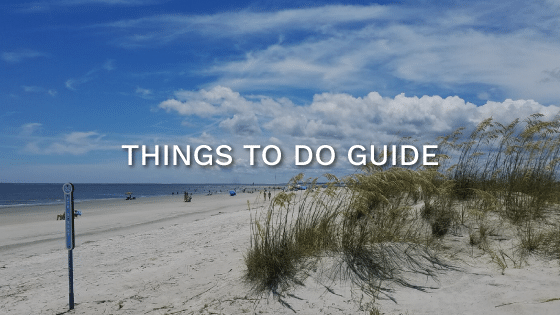St. Simons Island is the largest of the Golden Isles – a cluster of barrier islands off the Georgia coast that includes Sea Island, Jekyll Island, and Little St. Simons Island, as well as Brunswick on the mainland. St. Simons visitors and residents alike appreciate the laid-back island vibe that combines sophistication with natural beauty. The warm climate, pristine beaches, and ample access to adventurous recreation, original shops, and unique eateries make St. Simons a favorite destination for millions each year, but it wasn’t always a tourist hot spot. The charming community once named “America’s #1 Favorite Romantic Town” and “America’s #1 Favorite Beach Town” by Travel + Leisure Magazine has also served as the site of inspired history and a proud demonstration of the evolution of American society.
What really sets this island apart is it’s unique and vibrant history.
The earliest known inhabitants of St. Simons Island were Native American tribes of the Creek Nation, thousands of years ago. Whispers of the past still remain on the island in the form of shell rings and middens from the Guale Indians who established a permanent village here more than 500 years ago. Later, ownership and occupation of these lands would be contested by the Spanish and English at battlefields and sites that visitors still explore to this day. Eventually, the English secured the Georgia colony, taking advantage of the fertile soils and expansive lands to build thriving rice and cotton plantations. From its Native American roots to its wartime prominence, St. Simons Island holds a special place in United States history, and you can experience the echoes of yesterday today when you visit the area’s most remarkable historic sites.
Cannon’s Point Preserve
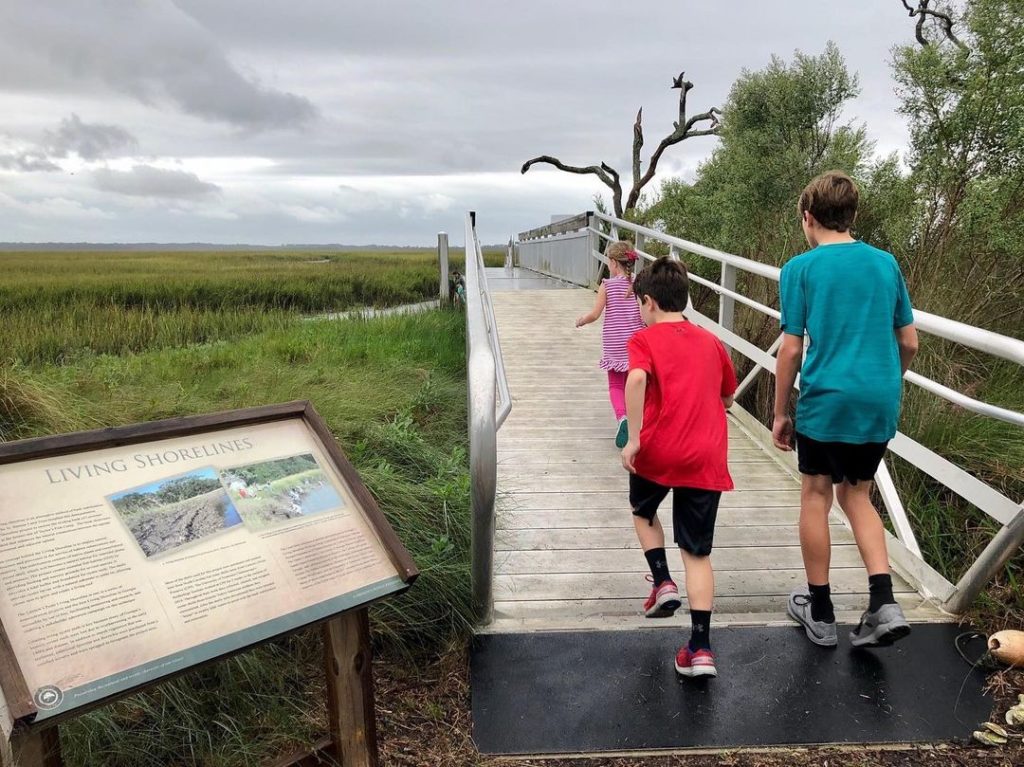
Cannon’s Point Preserve is a 600-acre space on the north end of the island. Its unique salt marsh, tidal creek, and maritime forest ecosystem provide a habitat for native wildlife like oysters, birds, fish, and manatee near the lower Altamaha River delta, one of the most ecologically fertile areas in the region. The rich river shores once made the preserve a desirable settlement for the Guale people, who dubbed it Guadalquini. There are numerous middens – remnants of the Guale tribes, as well as plantation ruins, and a Late Archaic shell ring spanning the preserve, which is maintained by the St. Simons Land Trust and a team of volunteers. Guests also have access to a small, non-motorized boat launch for canoes, paddleboards, and kayaks.
Visitors can expect an unspoiled wilderness experience, with no modern facilities, but restrooms are available nearby. Cannon’s Point Preserve is open to the public Saturday – Monday from 9AM – 3PM. Motorized vehicles are not permitted on the preserve, but limited parking is available at Taylor’s Fish Camp.
Fort Frederica

Also on the north end of St. Simons Island, Fort Frederica played a prominent role in the early settlement of the region. English occupation moved southward from Savannah as Spanish efforts to establish mission settlements along the coast continued northward from Florida. At the order of British General James Oglethorpe, the fort was constructed strategically at a bend in the Frederica River to fend off Spanish incursion, and a village took shape around it. In 1736, Oglethorpe established Fort Frederica, named after the heir to the British throne, Frederick Louis, Prince of Wales. In 1742, Britain’s victory over Spain in the Battle of Bloody Marsh sealed the fate of the state’s colonization. The battle site is considered part of the preserved Fort Frederica National Monument.
The Fort Frederica National Monument was listed on the National Register of Historic Places in 1966. Fort Frederica is open to the public and admission is free. The Visitor Center is home to a bookstore, soda machines, and restroom facilities, as well as a short film about the site. Parking is available on-site, along with a picnic area.
Christ Church
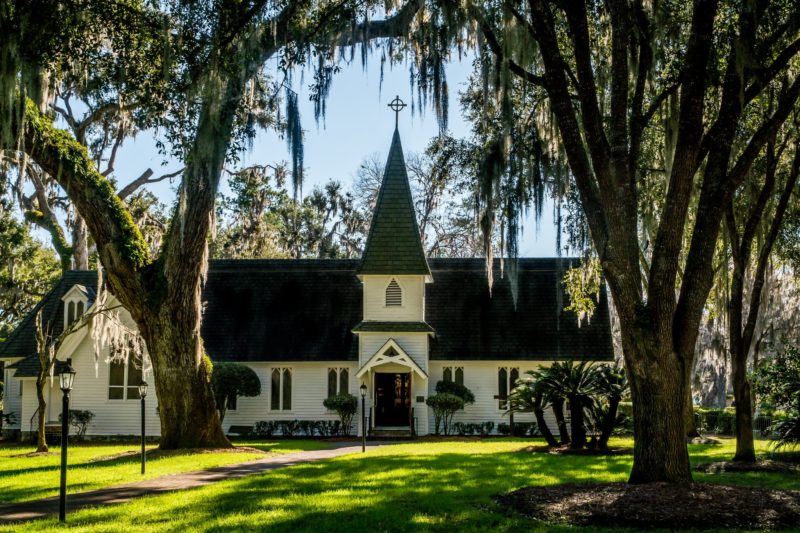
The same year that James Oglethorpe established Fort Frederica, brothers John and Charles Wesley began to assemble the congregants of what would later become Christ Church Frederica. Nestled among majestic holly, cedar, and live oak trees, the brothers led prayer and practices for the beginnings of the Methodist Church they would later introduce upon their return to England, and the early installation of organized religious practice in the burgeoning island village. Worship has been a fixture of the site since 1736, but the first church was not constructed here until 1820. After being partially destroyed during the Civil War, the church was rebuilt by the Reverend Anson Phelps Dodge, Jr., in memory of his wife. The church grounds include a cemetery, with gravesites dating back to the early 1800s. Many notable early residents and settlers are buried here, including Georgia author, Eugenia Price.
Christ Church, Frederica is one of the oldest churches in the state of Georgia, and one of the most photographed sites on the island. The breathtaking structure is as much a testament to architecture as is it to spirituality. Today, the church hosts an active Episcopal practice, but it is also open to the public for tours Tuesday through Sunday from 2PM – 5PM.
Gascoigne Bluff
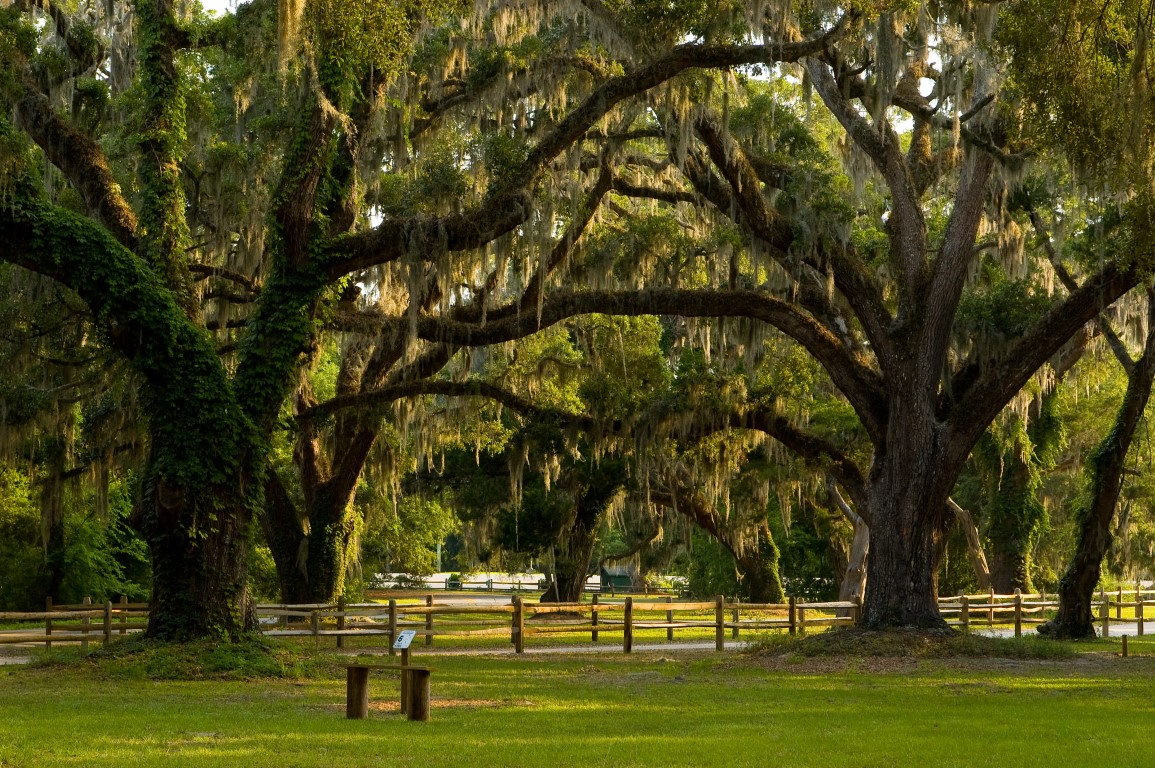
From the ruins of Fort Frederica, the new evolution of colonized Georgia began to take shape. Chunks of salvaged building material known as tabby were used in the building of sprawling plantations. This concrete-like substance made of water, sand, ash, and broken oyster shells, was favored by early settlers in coastal regions of the Carolinas, Florida, and Georgia. More than a dozen cotton plantations emerged, and rice crops were fruitful along the banks of the Altamaha River as well. The island became a prominent source of cotton production, known specifically for its long-fiber Sea Island Cotton. One of the most notable antebellum plantations arose on Gascoigne Bluff, a one mile tract of land along the banks of the Frederica River. Considered the “Gateway to St. Simons Island”, Gascoigne Bluff became the site of the expansive Hamilton Plantation.
Confederate troops attempted to protect the coastline at Gascoigne Bluff during the Civil War, but upon their retreat inland to re-enforce defenses at Savannah, Union forces occupied the islands, ultimately leaving the plantations in shambles. The damage to the once fruitful lands caused a shift in the area’s industry from rice and cotton to lumber. The island’s lumber exports began with the Naval Act of 1794. Timber harvested from thousands of Gascoigne Bluff live oak trees was used to build the USS Constitution and the five other original US Navy warships. The oaks were known for their decisive might, leading to the Constitution’s nickname of “Old Ironsides”. Almost a century later, lumber mills had sprung up in the area surrounding Gascoigne Bluff to continue the lucrative production process into the twentieth century. Gascoigne Bluff oaks even contributed to the construction of the Brooklyn Bridge in New York. The timber production also provided the resources needed to create the boats that would later serve to shuttle passengers from the mainland to the islands, giving rise to the start of tourism in the Golden Isles.
In 1950, the Methodist ministry and retreat center Epworth by the Sea opened on Gascoigne Bluff. It still occupies 83-acres of riverfront land, with state-of-the-art facilities and an array of faith-based events. Recreational facilities at Gascoigne Bluff include a fishing pier, picnic pavilion, fitness trail, full-service marina, and disc golf course. You can also visit the Cassina Garden Club Slave Cabins – the remains of the Hamilton Plantation. It is free to visit, open year round, and home to numerous community events throughout the year, like the Georgia Sea Islands Festival.
St. Simons Lighthouse
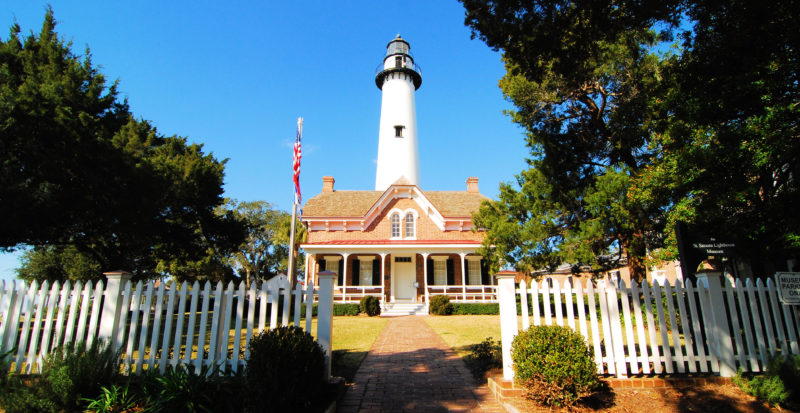
On the southern tip of the island at what is now Beachview Drive, the St. Simons Lighthouse was built in 1810 to aid in maritime navigation, and the defense of the barrier islands in the St. Simons Sound. The original tower was 75 feet tall. During an invasion by Union troops in the Civil War, the lighthouse was destroyed by retreating Confederate armies. A new, 104-foot lighthouse was erected in 1872, along with a keeper’s house. The St. Simons Lighthouse is one of only five remaining light towers in the state, actively guiding ships through the St. Simons Sound.
Today, the Coastal Georgia Historical Society preserves the history of the maritime landmark. For a fee, the public can tour the lighthouse’s museum, and climb the 129 steps to the top of the tower for panoramic coastal views that include Jekyll Island and Brunswick.
Torras Causeway
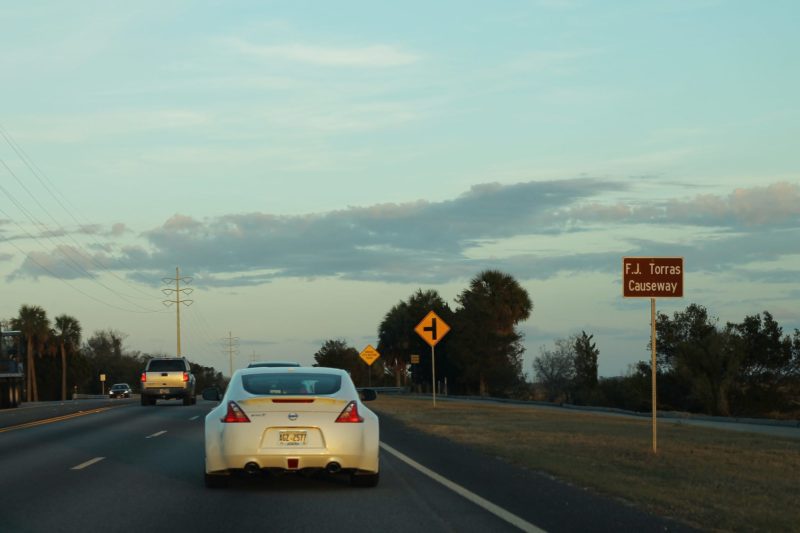
Construction of the pier and new hotels fed the growing tourism industry. As the south end of St. Simons Island began to develop into a summer resort community, the need for smooth and swift transportation from the mainland became evident, and passenger ferries weren’t enough to handle the influx of visitors efficiently, especially once the automobile became a factor! The Torras Causeway opened in 1924 as the Brunswick-St. Simons Highway, providing a pathway for visitors to drive from Brunswick and the south Georgia mainland to St. Simons Island, and accelerating the development of both residential and tourist facilities on the island. During World War II, the Golden Isles served to provide much needed respite to those stationed nearby, or the troops and families who had taken up residence at the newly designated Naval Air Station St. Simons, home to a Navy training facility and radar station (where The King and Prince Hotel now stands).
Aside from being the only roadway between St. Simons Island and the mainland, Torras Causeway offers a paved biking and walking path along its 4+ mile span. The scenic path provides sweeping views of the fabled marshes of Glynn County, where fishing and crabbing are the best ways to spend the day.
Regardless of where your journeys take you on St. Simons Island, you’ll surely have the option to play witness to the shadows of remarkable moments in American history and the birth of a nation. Through times of exceptional growth and even reconstruction, our coastal communities have thrived, evolved, and grown, contributing to ambitious efforts and the establishment of a flourishing society. Even as you appreciate our unspoiled beaches and modern resorts, you can’t help but take notice of the countless nods to the people and events that paved the way for it all.



